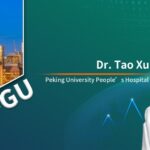With the rapid development of targeted therapy and immunotherapy, the field of leukemia treatment has undergone revolutionary changes. At the recently held “Chinese Society of Clinical Oncology (CSCO) Leukemia Expert Committee, Lymphoma Expert Committee, and Myeloma Preparatory Committee Working Meeting and the 2024 CSCO Hematology, Lymphoma, and Myeloma Disease Academic Conference,” domestic and international experts, both senior and junior, actively exchanged ideas and engaged in lively discussions on the latest developments and hot topics in leukemia diagnosis and treatment. During the conference, Oncology Frontier – Hematology Frontier specially invited Professor Hui Wei, one of the co-chairs of the leukemia youth session at this conference and director of the Leukemia Diagnosis and Treatment Center of the Institute of Hematology, Chinese Academy of Medical Sciences (Chinese Academy of Medical Sciences Blood Disease Hospital), to introduce the highlights of the leukemia field at this conference. Professor Wei also provided insights into the future treatment directions for ETP Acute Leukemia (ETP-ALL) and analyzed related challenges in CAR-T cell therapy.
Oncology Frontier – Hematology Frontier:As one of the co-chairs of the leukemia youth session at this conference, could you please introduce the highlights of the leukemia field at this conference that are worth paying attention to?
Professor Hui Wei: The leukemia session of this conference invited many experts in the domestic leukemia field, especially young experts, to delve into hot topics in leukemia research. In acute myeloid leukemia (AML), the focus was on small molecule targeted drugs for relapsed/refractory AML, including the current status and prospects of BCL-2 inhibitors, FLT3 inhibitors, IDH inhibitors, and emerging drugs expected to be launched in the future. In acute lymphoblastic leukemia (ALL), the emphasis was on immunotherapy, particularly CAR-T cell therapy, antibody immunotherapy, and the emergence of bispecific antibodies, which have brought about revolutionary changes in the treatment modalities and efficacy of B-cell acute lymphoblastic leukemia (B-ALL). Through mutual exchange and sharing of experiences among experts during this session, it is expected to greatly promote the better clinical application of new treatment strategies and drugs, ultimately benefiting more leukemia patients.
Oncology Frontier – Hematology Frontier:During this conference, you presented a report entitled “Diagnosis and Treatment of ETP Acute Leukemia.” Could you discuss the important updates in the diagnosis and treatment of ETP Acute Leukemia in recent years?
Professor Hui Wei: The diagnosis and classification of ALL have become increasingly refined, among which Early T-cell Precursor Acute Lymphoblastic Leukemia (ETP-ALL) is a type recognized in recent decades. It originates from the earliest T-cell precursors and has unique clinical features, including CD3 positivity, CD7 positivity, CD5 positivity rate <75%, and concomitant myeloid/stem cell characteristics. Therefore, in terms of efficacy, its short-term efficacy is significantly poorer, and many studies have found that its long-term efficacy is also unsatisfactory. Currently, chemotherapy remains the basis for treating ETP-ALL. However, novel immunotherapies and targeted therapies, including venetoclax, CAR-T cell therapy, CD38 antibody therapy, etc., are being attempted in ETP-ALL and are expected to become future treatment directions.
Oncology Frontier – Hematology Frontier:CAR-T cell therapy has been a research hotspot in the field of hematologic malignancies in recent years. Could you discuss the research progress of CAR-T cell therapy in the leukemia field and the challenges it still faces?
Professor Hui Wei: As a research hotspot in the field of oncology, CAR-T cell therapy in the leukemia field can be divided into several aspects: firstly, in B-ALL, CAR-T cell therapy is crucial and even considered the preferred option for treating relapsed/refractory B-ALL, primarily due to the presence of relatively good targets such as CD19 and CD22. Secondly, in acute T-cell lymphoblastic leukemia (T-ALL), as mentioned earlier, T-ALL also has relatively good targets, such as CD7. However, the application of CAR-T cell therapy in T-ALL still faces some off-target issues, thus requiring further exploration in the future. Lastly, in AML, due to the extensive overlap between the occurrence of myeloid leukemia and hematopoietic stem/progenitor cells (HSPCs), there is currently a lack of particularly effective treatment targets. Therefore, CAR-T cell therapy in AML often encounters serious off-target issues, mainly manifested as significant bone marrow suppression and immune suppression. Finding more specific and effective targets, i.e., antigens expressed on almost all myeloid leukemia cells, is the main challenge faced by CAR-T cell therapy in AML and is a problem that needs to be explored and researched in the future.

Chief Physician at the Institute of Hematology, Blood Diseases Hospital, Chinese Academy of Medical Sciences (Chinese Academy of Medical Sciences Institute of Hematology)
Director of Leukemia Diagnosis and Treatment Center
Deputy Director of the National Clinical Medical Research Center of Hematologic Diseases
Member of the Hematology Branch of Chinese Medical Association
Deputy Head of the Leukemia Lymphoma Group
Deputy Director of the Hematologic Oncology Professional Committee, Chinese Anti-Cancer Association.
Deputy Editor-in-Chief of Hematological Oncology
primarily engaged in basic and clinical research on leukemia


